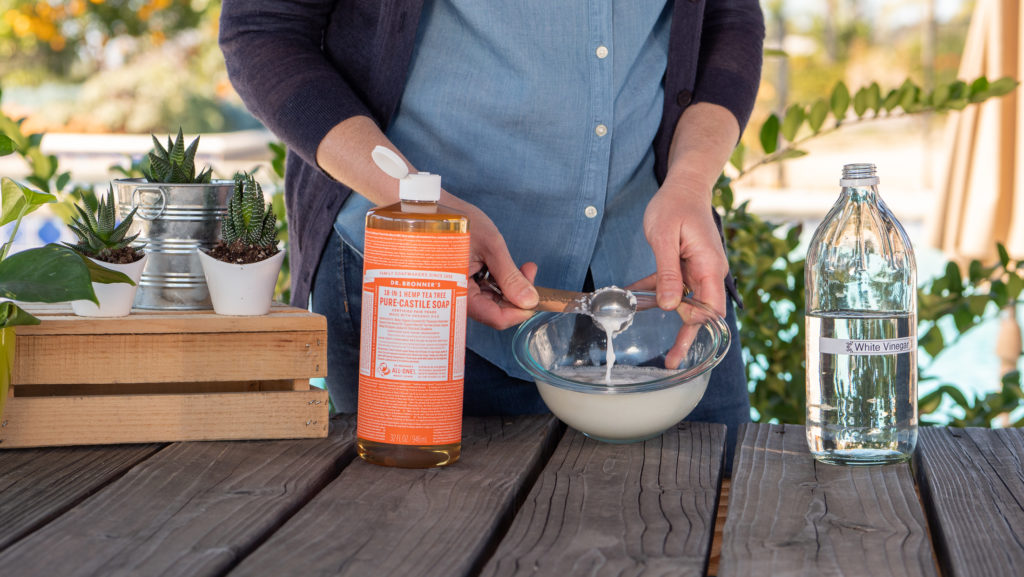
Dr. Bronner’s Castile Soap and vinegar can clean an entire house. They are effective, versatile, biodegradable and non-toxic. But the sole point of this post is to emphasize that these two should not be mixed directly. This is true for the Castile Soap and any acid – any vinegar or lemon juice.
Since there have been several recommendations in online recipes and on TV to mix these two together, I want to address this topic. It’s not a dangerous combination, but it’s definitely moving in the wrong direction as far as getting things clean.
Here’s why.
In great part it’s due to the fact that vinegar is an acid and the Castile Soap is a base. They will directly react with each other and cancel each other out. So, instead of getting the best of both (the scum cutting ability of the vinegar and the dirt transporting ability of the soap), you’ll be getting the worst of something entirely new. The vinegar “unsaponifies” the soap, by which I mean that the vinegar takes the soap and reduces it back out to its original oils. So you end up with an oily, curdled, whitish mess. And this would be all over whatever it was you were trying to clean – your laundry or counters or dishes or whatever.
Check out this zoomed in picture of Dr. Bronner’s Peppermint Castile Soap mixed directly with distilled white vinegar:
It doesn’t matter what else is in the solution, or in what order you combine them. If you end up with the soap and the vinegar in the same container, this reaction will occur. The only exception to this is if you buffer the soap with baking soda, which is another alkali. You’ll see this in my recipe for GIY Soft Scrub. In this case, vinegar reacts more readily with baking soda, and that reaction will take place first. For the Soft Scrub, it serves the purpose of creating that lovely, vertical clinging foam. If there is still unreacted vinegar, it will then react with the soap, which is why the ratios are important to maintain.
The mom in me has to point out that if you have kids who wonder about the purpose of science class in “the real world,” you can show them this little reaction. Of course, drinking milk and orange juice at the same time will also point out why you should know your acids from your bases.
So, for cleaning, there is a better way. Use the soap to clean and the vinegar as a rinse agent.
One common complaint with using the Castile Soap, especially on hard or shiny surfaces is that it leaves a film behind. This film is caused by the soap reacting with minerals in the water. It is not actually soap itself left behind, but rather certain salts. When this builds up on sinks and tubs, we call this soap scum. Vinegar is a great way to cut this. So after you’ve handwashed your dishes with Castile Soap and rinsed them, dip them in a sink of vinegar water. Or after you’ve wiped down the sinks and tubs with soapy water, rinse, and then spray with a vinegar solution (about 1 cup vinegar/quart water).
I’ll give more time to windows later (one of the things I actually really enjoy cleaning), but briefly, for dirty exterior windows, spray them with my Castile Soap solution, wipe them with a chamois, then spray them with vinegar and squeegee. Works great! Better than Windex.
Also, on the hair, if you do not have our Citrus Hair Rinse, but just want to use vinegar or lemon juice, rinse the soap out of your hair first. Then apply the vinegar or lemon juice.
So Dr. Bronner’s Castile Soap and vinegar are a fabulous one, two punch. One after the other. Not at the same time.
Help! I did what I wasn’t supposed to do and mixed Castile Soap and vinegar. How do I clean it up?
The best way to remedy this is to re-wash the surface with the recommended dilution of Sal Suds or Castile Soap (If handy, Sal Suds is slightly better at grabbing the oils). In the case of laundry, wash the load with the recommended amount of Sal Suds or Castile, and with an added 1/2 (120 mL) cup baking soda (¼ cup [60 mL] in HE) and a pre-soak or pre-wash cycle.
As a sidenote: As a synthetic detergent, Sal Suds has a completely different chemical makeup than a true soap such as Castile Soap. While vinegar doesn’t cause it to unsaponify, adding even a small amount of vinegar to Sal Suds significantly reduces its cleaning and degreasing power.
Further reading
- What Can You Mix with Dr. Bronner’s Sal Suds?
- What Can You Mix with Castile Soap?
- Sal Suds Dilution Cheat Sheet
- Dilutions Cheat Sheet for Dr. Bronner’s Liquid Castile Soap
This use and many more are in my book, Soap & Soul: A Practical Guide to Minding Your Home, Your Body, and Your Spirit with Dr. Bronner’s Magic Soaps, available now in hardback on DrBronner.com or at your favorite bookseller, and as an eBook and audiobook (read by me!) from wherever you download or listen.

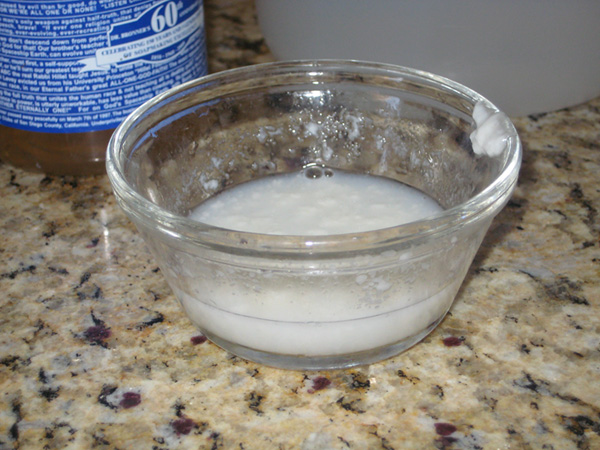




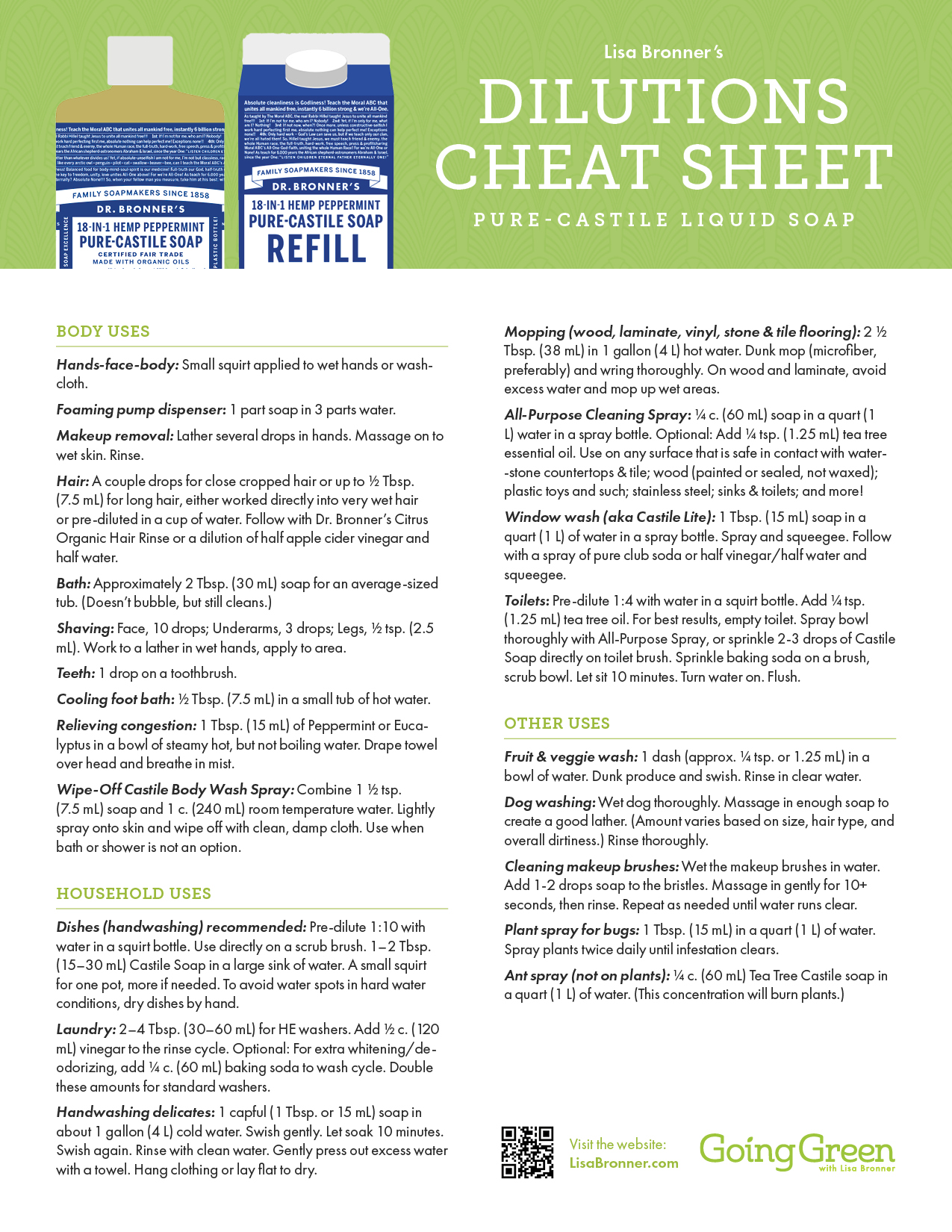
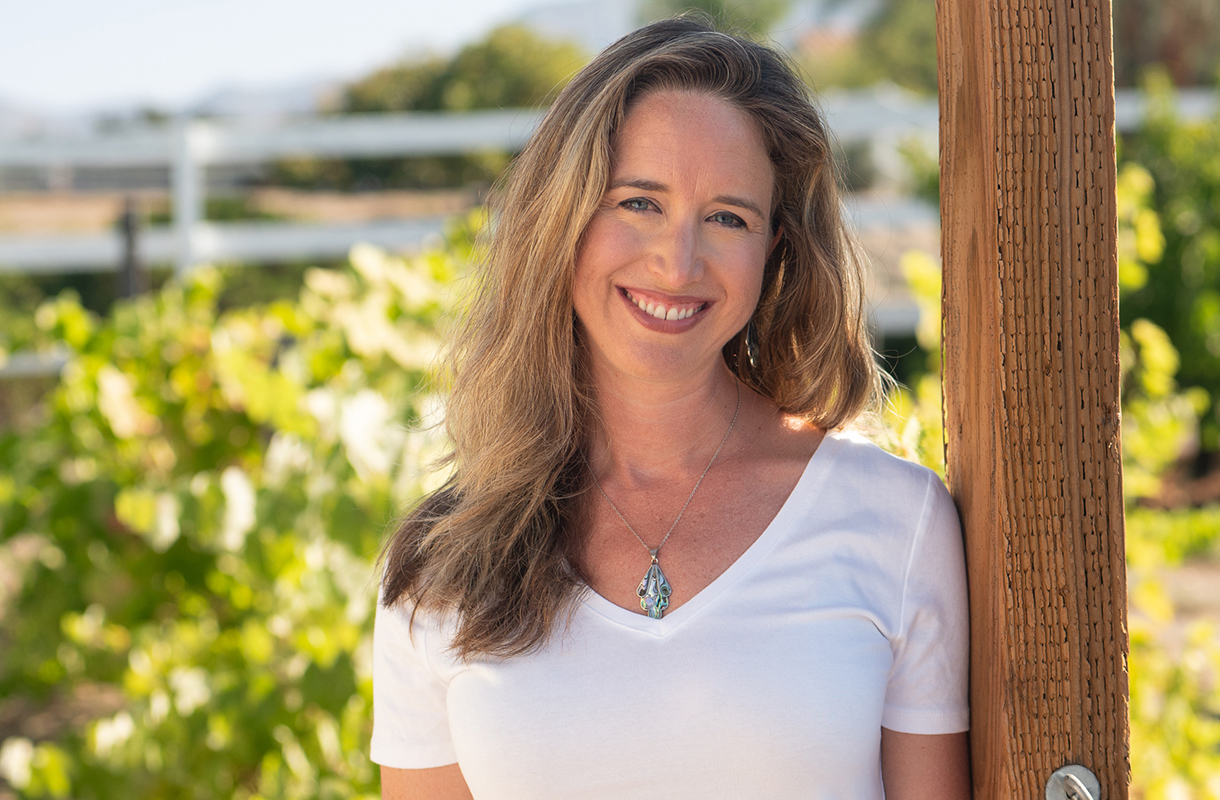

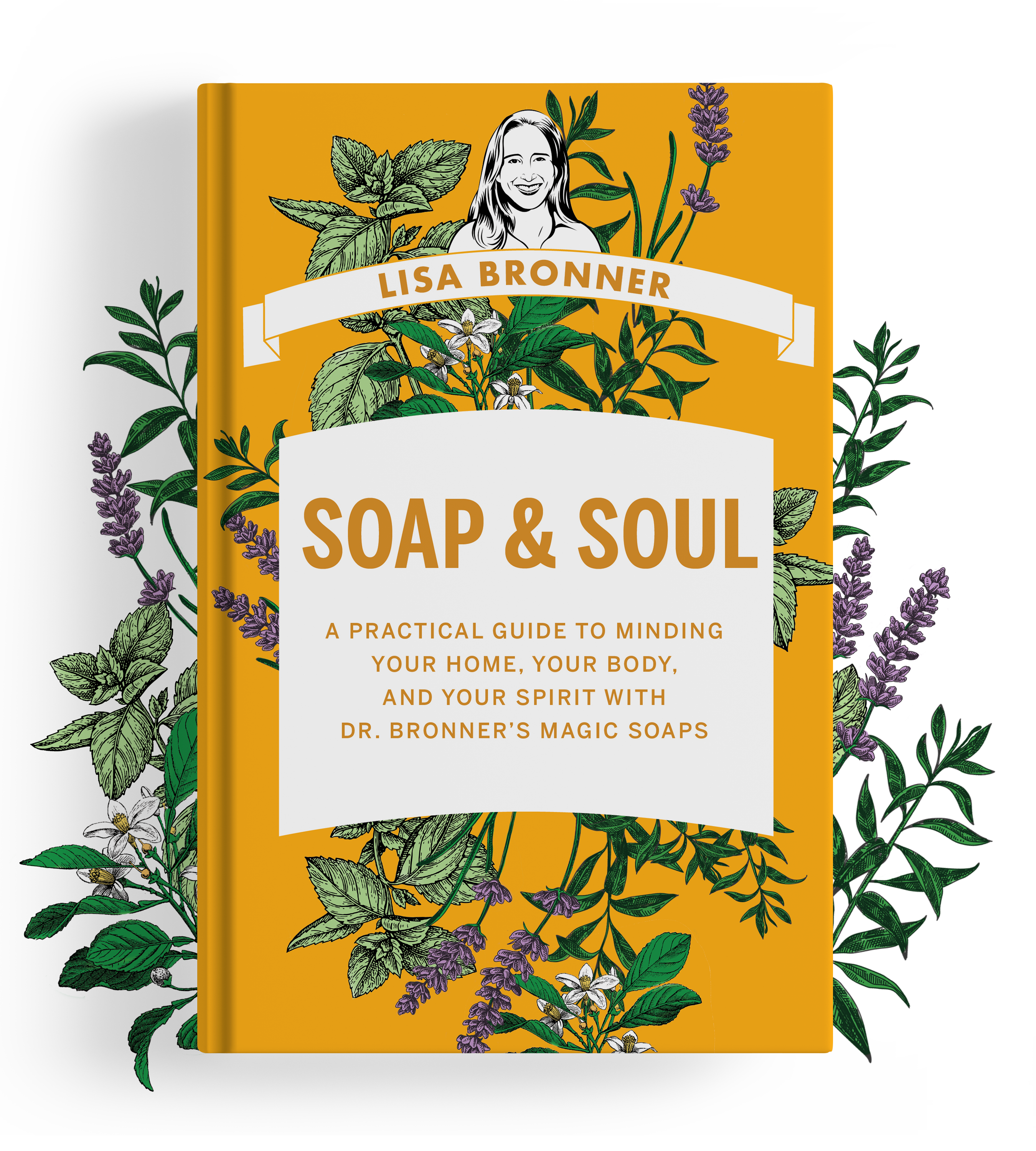
How do you feel about using sal suds as a laundry detergent and adding vinegar to the rinse cycle?
Hi Julie- Good question! When added to the fabric softener compartment of the washing machine, the vinegar is dispensed during the rinse cycle, after Sal Suds or Castile Soap has been rinsed out of the fabrics. There’s no mixing of the two in this process.
I did something foolish, I used some Lavender Castile soap NOT diluted on my Sunbrella fabric couch, thinking I can treat some stains. Now my couch looks like it has oil stains!! I scrubbed them but they are not budging. Please help me!
Hi Stella- My guess is that there is unrinsed soap still left in the fabric. When soap remains on a surface it ends up holding on to dirt. I recommend going over these areas with a strong hose until no more bubbles emerge.
Hm. You may be able to rent a specialty vacuum or the cover on your sofa cushions might be unzippable or you may be able to cautiously try a shop and or wet dry vac, I got mine at Kmart for thirty bucks. Vinegar might help dilute the soap. The key is don’t let yourself panic. So if you get upset make yourself walk away from the problem for a day. If you get really stuck on the Internet these days you can find actually cute and fashionable sofa slipcovers that are not ugly like slipcovers used to be. Don’t use baking soda bc it will probably enhance not dilute the soapiness. Theoretically if you can get it to dilute at all a powdery substance in top of it might help absorb it (cornstarch or baby powder or similar just not baking soda). Sorry if that sounds weird. Water temperature probably matters. You don’t want to take color out of the fabric so cold water probably to start and if you really get stuck like very you can test on oart of the sofa that isn’t exposed. And finally you could call the sofa company and just ask to replace a cover maybe. The sal suds are super strong – I use the minimum amount on the label for laundry bc otherwise it’s way too much. I still like it bc it smells good and in a pinch I can use it for hair or body wash and it’s a great degreaser. I wonder if there’s a finish on your sofa fabric that the soap may be reacting with. Maybe you should call the sofa company. Some fabrics have finishes over the fabric you can’t see, for example to make things flame resistant and safer. True story.
I’ve heard distilled water and heard you have reverse osmosis water on your videos,what other kinds of water can be used to dilute castile or Sal suds?spring water?
Hi Missy – Any water can be used with Sal Suds. Unlike the Castile soap, it does not react with minerals in hard water, and is clean rinsing in any water. With the Castile soap, it does react with minerals in hard water to make a cloudiness that is completely harmless, but can leave a film on shiny surfaces. To eliminate that, you want a type of water that is free from minerals. Distilled and reverse osmosis filtered water both have had minerals removed. Certain filtrations systems also do. Spring water is not filtered to remove minerals.
In the book “Clean House, Clean Planet” by Karen Logan, the Earth Scrub on page 239 calls for baking soda, a high quality liquid soap, white distilled vinegar, and water. I used this yesterday to clean my tub and it worked well. Are you sure these should never be combined?
Hi Heidi – An excellent book! And my first green cleaning handbook. The reason the soap and vinegar can coexist in this soft scrub is because the baking soda runs interference. Baking soda is another alkali. Vinegar reacts more readily with baking soda than with castile soap, and so the reaction vinegar/baking soda reaction will take place first. This reaction creates that lovely, vertical clinging foam. You’ll note that I mention this as the exception to the vinegar/soap combo principle.
I believe unless I’m mistaken that vinegar and baking soda form an acid so strong it can dissolve pennies, the newer pennies that aren’t copper. It’s the sodium in the baking soda that does this. It also burns most carpets. So I’ve personally seen both these with my own eyes so I wouldn’t do it.
Hi All – To shed a little more light on this, vinegar and baking soda react to form carbon dioxide gas, sodium acetate, and water. The carbon dioxade fizzes off. Sodium acetate is mildly alkaline. While the none of these resulting chemicals is a great cleaner (water is the most useful of the three in cleaning), none are particularly harmful.
Can Sal Suds be mixed with vinegar?
Hi Bonnie- Vinegar does not react with Sal Suds, which as a detergent is inherently more stable. However, we recently did effectiveness testing on this one because I get a lot of questions, and Sal Suds mixed with vinegar is less effective at cleaning than Sal Suds alone.
I just washed my hair with the unscented baby Soap Sunday it is so soft.. but I didn’t know I had to rise with vinegar! Why is that??
Hi Crystal – There is so much variance in hair types and style preferences that there is no one way that works for all. If washing with the Unscented Baby Castile works well for you, there is no reason to do anything more. Some people find that their hair isn’t as soft as they would like, and so they need the vinegar (or lemon juice or Citrus Hair Rinse) rinse afterwards to smooth the hair. But for you, there is no reason to do anything more!
I see on the net people using vinegar mixed with dish soap to kill weeds.
The acid from the vinegar kills the weeds and I think the purpose of the soap is to better coat the weeds without the vinegar dripping off. But dish soap is still toxic.
Could Sal Suds be mixed with vinegar to make weed killer?
Thank you in advance,
Nate M
Hi Nate- Vinegar, when mixed with Castile Soap, will cause the soap to unsaponify – or turn it into a goopy, oily mess. Sal Suds does not have the same reaction with vinegar, although I’ve not tried this recipe specifically. Take care if using, as vinegar is considered a non-selective herbicide, which means it will kill any plant it touches and could change your soil chemistry, rendering it difficult for growing anything in that spot in the future. In cracks and seams between pavers and bricks and such, I pour plain boiling water on them. For a large weed, you can cut the top growth before pouring the water. Because I am in such a dry climate where we get no rain from April to December, weeds aren’t as tenacious as elsewhere. I just clear them out by hand, pulling their roots. I realize I’m not offering a solution for large areas. Let’s see what other readers have to say.
The suppose of the soap is to breakdown the plants cell wall. I use vinegar, salt, and soap mix to kill weeds (note: it will kill all plants, not just weeds)
It seems like a hassle to be using first the soap and then the vinegar, There must be some easier way.
Hi Alina- If your washing machine has a fabric softener compartment, add the vinegar right in there! It will automatically be dispensed into the rinse cycle. I’ve also heard from customers that putting it into a Downy ball, or similar dispenser, works well – although I’ve not personally tested this.
[…] vinegar and soap are mixed together there’s a chemical reaction, and not a good one. According to Lisa Bronner, vinegar unsaponifies the soap. This means the soap is no longer soapy and can’t do its job. […]
[…] el vinagre y el jabón se mezclan, se produce una reacción química, y no una buena. Según Lisa Bronner, el vinagre dessaponifica el jabón. Esto significa que el jabón ya no es jabonoso y no puede hacer […]
I use liquid homemade laundry detergent which is Castile soap base & looks like the chunky demo picture then I use white vinegar as softener & put it in my fabric softener dispenser.
Even thought it’s not mixed directly together, it’s probably mixed together during a cycle.
Does the rules still apply for a system like this??
Hi M.De- In a washing machine (front or top loader), the fabric softener is dispensed during the rinse cycle, after the soap or detergent has been rinsed from the fabrics, and so the Castile Soap and vinegar wouldn’t be in the tub at the same time. For more on laundry with Castile Soap, see my blog post, Green laundry Care with Dr. Bronner’s: https://www.lisabronner.com/green-laundry-care-with-dr-bronners-video/.
Is it septic safe to use Castile soap in a DIY laundry soap and then use vinegar for the rinse cycle?
HI Jodie- Our Castile Soaps biodegrade and are safe for septic systems. We had them analyzed for biodegradability, specifically for the use in grey water systems in Australia, and the issues are the same for septic. Likewise, vinegar is safe for septic systems as well.
I use Dr Bronners as a laundry detergent and vinegar as a fabric softener.
What can I use as a bleach alternative with these products?
Thanks so much!
Hi Theresa- To whiten and brighten clothes, add ½ cup baking soda to the wash cycle for extra scrubbing action. (Halve this amount in an HE washer). While Castile Soap works very well on laundry, I find Sal Suds to be slightly better at whitening and brightening. And, unlike a true soap such as Castile Soap, it doesn’t react with minerals in hard water than can cause fabrics to stiffen or become less absorbent over time.
Sal Sads has Sodium Lauryl Sulfate
Hi Alina- Sal Suds, our household cleaner, is formulated with Sodium Lauryl Sulfate (SLS) because of its keen ability to cut through grease and grime and to generate suds. Studies have consistently shown that SLS is safe to use in low concentrations and in products that are meant to be rinsed off – both of which are true of Sal Suds. The main concerns with SLS is that it can be a skin irritant for some people because it can be so drying. It is so good at picking up oils that it pulls them right out of our skin! You won’t find SLS in any of our personal care products (Castile Soap, All-One Toothpaste, and so on) and personal care products that do include it should be avoided. For a deeper dive into SLS, check out my blog post on the topic: https://www.lisabronner.com/there-is-no-cancer-risk-from-sls-sodium-lauryl-sulfate/
Do you dilute the lemon or vinegar for a hair rinse
Hi Vernon- Yes, dilute the apple cider vinegar (ACV) by about half – to a ratio of 1 part ACV to 1 part water. Lemon juice is slightly more acidic, so increase the water to about 1 1/2 parts. Be sure to strain pure lemon juice first. I learned that the hard way after picking lemon pulp out of my hair for days!
I used a combination of Castile soap and vinegar in my steam cleaner and now have oily film in my reservoir, which I don’t know how to remove. Any suggestions?
Hi Mary beth- I’m so sorry that happened to you! As you’ve found, vinegar causes the Castile Soap to unsaponify. Soap and hot water will clean the gunk out of the reservoir.
This article mentions the reaction being caused by the acidic vinegar and/or additions like lemon juice. I have not yet found any post about not using citrus essential oils in the Castile Soap or Sal-Suds but I would assume the reaction would be created the same if you used any citrus essential oil with Dr. Bronner’s. Is this correct?
Hi Colette- Happily, essential oils do not react with Castile Soap. Citrus juice and citrus oils are extracted from different parts of the fruit and have different pH level. Citrus juice is extracted from the pulp of the fruit, is acidic and water based. Citrus oil on the other hand, is extracted from the peel of the fruit and doesn’t have much of a pH because it is not water-based.
How about mixing Sal Suds with Vinegar in the same bottle? Sal Suds is a detergent, so would it cause the same outcome?
Hi Ashley – Sal Suds does not react as readily with the vinegar, but I don’t see an advantage to mixing these two. Sal Suds on its own outperforms the vinegar’s ability to clean.
This article was great and I wish I had read it yesterday before I mucked up a load of dishes. I decided to use my large bottle of Dr. Bronners, that I had just emptied into my smaller one for hand soap, and make it into a spray bottle for cleaning…so added vinegar. Unfortunately I tried to clean the container in a load of dishes..And had a mess. I could have added baking soda!
Thanks for the report and I love Dr. Bronners soaps.
[…] Some people choose to make their own cleaning products, which in some cases can be a good (and frugal) option. But proceed with caution – some ingredients in homemade cleaning products can also be hazardous to your health. Borax, a common ingredient in homemade laundry detergent recipes, is associated with reproductive, developmental, and neurological hazards, and some essential oils, often used to provide a natural fragrance, can cause sensitization and allergic reactions and can be harmful to pets. Plus, some combinations of ingredients that are safe and effective cleaners on their own become ineffective when combined. For example, when baking soda and vinegar are mixed, they neutralize each other, reducing cleaning effectiveness, and mixing vinegar with castile soap unsaponifies the soap, resulting in an oily, curdled mess. […]
How can I best clean my Corian countertops in the kitchen to make them really shine? Thanks.
Hi Sharon- An All-Purpose Spray with either 1 Tbsp Sal Suds or 1/4 cup Castile Soap in a quart or water will clean them beautifully. Spray and wipe with damp cloth.
Hi,
Been using your 18-in-1 peppermint pure castile soap for quite some time but an old bottle has coagulated on top of the liquid. It is a foamy/hard substance and one needs to really shake the bottle hard to break it free to get to the liquid. I’ve tried soaking the bottle in warm water and then laying the bottle down sideways but the whitish foam keeps rising to the top and seals the liquid beneath it. Please help. Thanks
Hi Robert- I haven’t heard of this, but if it is an older bottle, that could be the cause. Our soaps have a guaranteed shelf of life three years unopened, and two years once opened. If you can provide me with the laser engraved code below the label, that will tell me the manufacture date.
Thanks for sharing!! I came here wondering how to reduce the film and help unclog my bathroom sink (which I think has been getting worse the more and more of this we use to wash our hands). Glad to know I can try vinegar to help remove the film! Didn’t know it was a problem until I noticed it. Fingers crossed this helps and I continue loving the use of this product! Could be exacerbated by the tap water in my area.
I heard that using distilled water is better to clean with than using tap water when you make a solution.
Hi Kathleen- Some people choose to use distilled water for a clearer solution. Castile Soap reacts with the minerals in hard water making for a slightly cloudy, although still effective, solution.
I accidentally mixed vinegar in straight Dr.Bronner’s after reading directions wrong. How do I clean up the slime from everything it touched?
Hi Lydia- I’m so sorry to hear that happened! Castile and vinegar are both great green cleaning ingredients – just not together. Sal Suds and hot water will help clean up. Start with 1 Tbsp. in a quart of water in a spray bottle. Spray, then wipe with a damp cloth. Increase the dilution if needed.
Against my better judgement, my wife has been using a water-vinegar solution to clean everything for some years. Now, as predicted, very expensive plumbing fixtures and mirrors are showing damage from repeated exposure to the acidic solution. Chrome plate is failing and silver coated glass (mirrors) are failing. If Castile soap leaves a film if not rewashed with vinegar, than it does not sound like a very good solution to this problem. Any comments are appreciated.
Hi Bob- The mineral deposits associated with hard water and Castile Soap only happen if the surfaces are left to air dry. If you spray the surfaces with the All-Purpose Spray and then wipe with a damp cloth, there will be no residue left behind. With that in mind, if after normal use, bathroom surfaces, such as sinks and showers, are wiped down, there will not be the accumulation of soap scum. I know that’s not how most of us use bathrooms, but it’s a good way to prevent the mineral deposits.
Thank you for finally giving me a FULL answer to this question! I keep seeing suggestions of putting castile soap and vinegar together, then I see posts about not doing so as you’ll get a gloppy mess. But no one has given a concise answer as to how to use them in conjunction. I have been using both, and having great success separately, so I have been wanting to figure out how to combine these successes without creating a huge mess. Clean with castile, rinse with vinegar. Perfect and simple. Thank you!
Any idea why this happens when I mix Dr. Bronners with tap water??? Nothing else. Just tap water. The water gets all white and when I put my hands in they get all oily and greasy feeling.
Hi Rhonda- Likely the pH of your tap water is low and the acidity is causing this reaction with the soap. That’s probably not what you wanted to hear. You can get a test kit for your water, or just to test the pH, you can take it to a pool supply store.